

Jon Clements, Author (unless otherwise noted) and Editor
Current degree day accumulations
Massachusetts Agricultural Calendar 2016 Photo Contest
| UMass Cold Spring Orchard, Belchertown, MA |
23-May |
| Base 43 (SkyBit) | 602 |
| Base 50 (NEWA) | 251 |
| Coming events | Degree days (Base 43 BE) |
| Codling moth 1st flight peak | 557-977 |
| European red mite 1st summer eggs | 447-555 |
| Lesser appleworm 1st flight peak | 354-772 |
| Obliquebanded leafroller pupae present | 601-821 |
| Lesser peachtree borer 1st adult catch | 480-676 |
| Oriental fruit moth 1st flight peak | 331-537 |
| Pear psylla hard shells present | 493-643 |
| Plum curculio oviposition scars present | 485-589 |
| Redbanded leafroller 1st flight subsides | 598-894 |
| San Jose scale 1st adult catch | 435-615 |
| San Jose scale 1st flight peak | 557-739 |
| Spotted tentiform leafminer mines present | 367-641 |
*adapted from Scaffolds Fruit Journal
Key insect life cycle and management dates (and some disease and horticuluture stuff)
Note: for 2016, we have five Massachusetts orchard locations subscribed to AR: Belchertown, Easthampton, Deerfield, Groton, Phillipston, and Sutton. The website for looking at AgRadar for these locations is: http://extension.umaine.edu/ipm/ag-radar-apple-sites/. What follows is for the Belchertown location.
Estimated apple Scab Ascopsore Maturity, 16-May -- 94%
Codling Moth (CM) -- 1st generation, first sustained trap catch biofix date: May 18, Wednesday. Codling moth development as of May 24: 1st generation adult emergence at 7% and 1st generation egg hatch atr 0%. In most orchards, insecticide targetted against plum curculio and apple maggot prevent codling moth damage. If targetted codling moth control is needed, key management dates are: 1st generation 3% CM egg hatch: June 6, Monday = target date for first spray where multiple sprays needed to control 1st generation CM.
Lesser Appleworm LAW -- 1st LAW flight begins around: May 13, Friday. Peak trap catch: May 22.
Oriental Fruit Moth OFM -- 1st generation OFM flight starts: April 23, Saturday. 1st generation 55% egg hatch and first treatment date, if needed: May 26, Thursday.
Plum Curculio (PC) -- Increased risk of PC damage as McIntosh and similar varieties increase fruit size: May 22, Sunday. Earliest safe date for last PC insecticide spray: June 1, Wednesday.
San Jose Scale (SJS) -- First adult SJS caught on trap: May 20, Friday. 1st generation SJS crawlers appear: June 17, Friday.
Spotted Tentiform Leafminer STLM -- 1st STLM flight, peak trap catch: May 8, Sunday. 1st generation sapfeeding mines start showing: May 21, Saturday. Optimum sample date is around Sunday, May 22, when a larger portion of mines are visible.
White Apple Leafhopper (WAL) -- 1st generation WAL found on apple foliage: May 13, Friday.
NEW: Apple Bud Freeze Mortality Estimates -- Date: Wednesday, April 6, Estimated Potential Bud Freeze, 43%; Date: Tuesday, April 5, Estimated Potential Bud Freeze, 38%; Potential Cumulative Crop Recuction, 64%.
13-July, 2016 (Wednesday) Massachusetts Fruit Growers' Association Summer Meeting, UMass Cold Spring Orchad, 391 Sabin Street, Belchertown, MA. Details TBA.
For more information and updates, see Upcoming Events
Jon Clements
Let's see what's on my mind this morning?
Fire blight snuck up a bit yesterday-today, it rained, it was warm enough for bacteria bulid-up, some bloom is still open (can't it just be over?) so the models are predicting moderate to high risk for infection. If in doubt, get some streptomycin (24 oz/acre) and Regulaid (1 pt/100 gallons, do not concentrate) out there on open bloom within 24-48 hours of infection (24 hours preferable). More in Diseases...
Apple scab maturity is near 100%, but not quite there yet, pretty significant infection period it looks like this morning (if leaves were wet long enough?), so you want to have been protected, if not, better get some kickback on ASAP (Flint, Inspire Super, etc.); I will bet we will be done Memorial Day (the old one, May 31). Any scab from previous infection periods showing up yet? Should be...see article below by Cooley et al.
Codling moth flight has started with first catch in pheromone traps, plum curculio activity going to be strong this weekend, time (soon) for a good dose of Imidan, Avaunt, Actara, Exirel, etc. I observed European apple sawfly in bloom in several locations last week, but they don't hold still for long, so hard to get a picture. Also caught several in pheromone traps. Indeed found classic egg-laying injury in Zestar!, along with plum curculio damage (already), out-of-focus picture below. Post petal-fall insecticide spray advised ASAP if I have to repeat myself...
Gypsy moth have been seen actively feeding in young trees, don't let them get out of hand!
Chemical thinning, I am leaning towards needing more thinning now than we might have thought. Any damage wrought by the freeze has appeared, so what you are seeing now and you are thinking it needs some thinning, trust your instinct. Carbaryl is the most mild thinner, but this weekend is going to be a good time to apply Maxcel/ExilisPlus (6-BA), a moderate thinner at moderate rates, or Fruitone at 2 oz per acre (3 oz per acre in big trees) when more aggressive thinning is desired in blocks where fruit are clustered and appear to be growing. Probably not going to want to use combinations of chemical thinners. Only thin what needs to be thinned, blocks with good fruit set, tops of trees, etc. There will be a significant carbohydrate deficit in trees this weekend (see below), so they WILL respond to chemical thinners -- use judiciously, use low to moderate rates. Read more from Duane Greene...
Are we having fun yet?
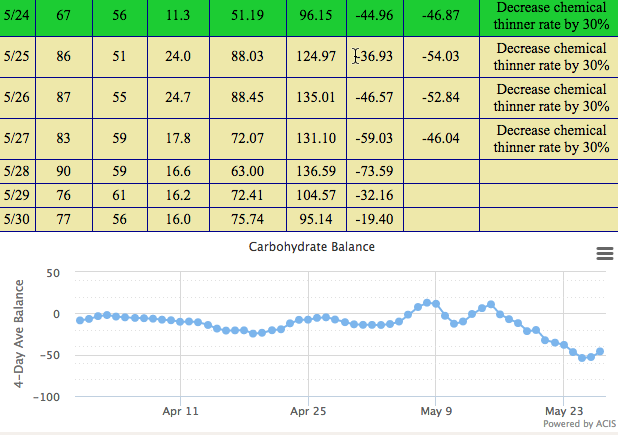
|
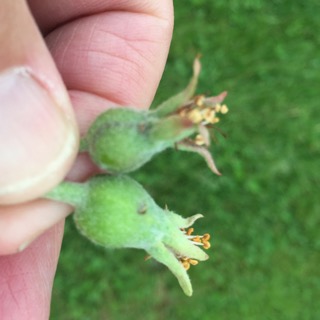 Out of focus, but European apple sawfly (top) and plum curculio (bottom) injury to Zestar! |
|
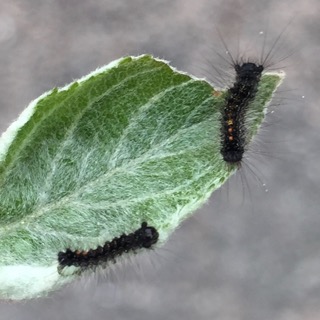 Gypsy moth caterpillars on young apple trees -- don't let them get out of hand! Imidan should clean up pretty quick. |
 codling moth caught in pheromone trap, has not been consistent enough yet to set biofix though |
Elizabeth Garofalo
Pear psylla is still on the move and laying eggs! This tiny, cicada-like insect has four generations per season and goes through five nymphal instars (early-the yellow one- and late- the brownish one- pictured below). If you find this critter (check ten shoots on five trees per block, the action threshold for this time of year is 1.5 nymphs per shoot) in your pears there are still a few things left you can do to mitigate populations leading into next season. The window for a petal fall spray application has passed but there will be another opportunity to treat in mid-June (many options, consult New England Tree Fruit Management Guide). Psylla has a high likelihood of resistance development to insecticides so, if you find your trees are over threshold, be sure to rotate active ingredients. Aside from chemical control, you do have some cultural options as well. In late June or early July, removing water sprouts will minimize the feeding sites for the third and fourth generations. Minimizing hard pruning and using only the minimum nitrogen required to maintain crop health will also minimize tender green tissue present for this pest to feed on.
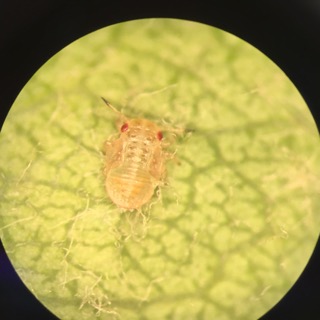 |
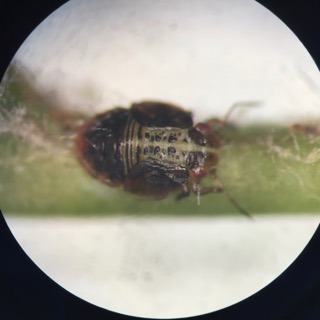 |
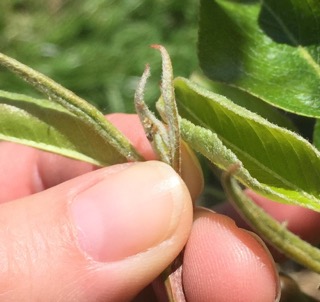 pear psylla activity evident on pear shoot |
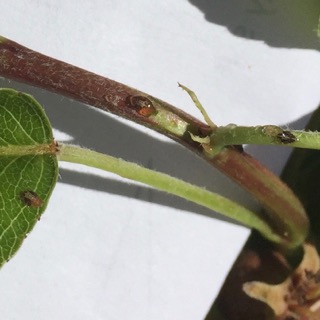 pear psylla close up of "hard shells" and honeydew already being secreted by pear shoots |
Liz Garofalo, Paul O’Connor, Arthur Tuttle and Dan Cooley
Apple scab remains an issue for the next couple of weeks, for a couple of reasons. First, there are still enough ascospores available to be a concern. NEWA says that primary season has ended in all but the coldest parts of MA, but models say that we won’t be done until this weekend. We’re still catching ascospores. As Liz put it:
Without further ado, here are this weeks spore counts! The two-fan field trap contained five measly spores, from the barley perceptible rain we had on May 19. We are, however, still catching a significant number of mature spores in the lab, indicating that there is indeed inoculum around. We counted 811 ascospores in the Petri plate assay and 699 in the funnel trap. I am completely baffled by the numbers we have seen this week. In the past trap catches tapered off to an end, rather than peaking again. Not this year! Stay tuned for next week’s exciting installment of “how many ascospores can one person (ok, so there are three of us actually) count?”
That means the rain today (Tuesday May 24) is an important infection period. If trees were not protected going into the rain, then a fungicide with post-infection activity should be applied as soon as possible, and by Thursday morning at the latest. Mix all post-infection fungicides with a protectant, either mancozeb or captan.
By now, any mistakes in scab sprays should start to be showing up. Infections from early May will have had time to cause visible scab on leaves by this weekend. If there is scab, then that means rain can lead to secondary infections, so don’t stop scab fungicide applications until it is clear that that no primary infections have gotten started in a block.
Fire blight risk has shot back up, starting with rain today (Tuesday May 24), and is predicted to be extreme through the weekend. The prolonged bloom has made it necessary to apply another streptomycin application where there are open flowers. The fact that there are far fewer flowers than there would be at king bloom decreases the chances of a major epidemic, but doesn’t mean that infections won’t develop on unprotected trees.
An application of 24 oz. per acre streptomycin plus 1 pt. Regulaid/100 gallons will reach back 24 hours, and protect flowers today and tomorrow (Wednesday). Where flowers continue to open on Thursday, another streptomycin application will probably be needed on Friday as risk levels will remain high into the weekend. Although, if you are at the tail end of bloom, and you sprayed strep yesterday or today, thus all your open flowers are covered, you are probably OK for the duration.
 Scab ascospore maturity estimated by five different decision support models at the UMass Orchartd. The green dashed line shows 95% of ascospores have matured, considered the point at which the next rain will be the last ascospore release of the season. The earliest date, NEWA, was May 15, and the latest, RIMpro N, May 29, roughly a two week difference. Our spore counts agree much better with the later estimates. |
|
Thinning During the Traditional Thinning Time (Duane Greene)
Fruit in nearly all areas are growing and this provides important information to aid in making chemical thinning decisions. The weather during the past two weeks has been generally cool and sunny to partly sunny conditions providing an environment that results in a carbohydrate accumulation. The trees have not been stressed and this provides the best case scenario to allow fruit on injured spurs to grow. Initial set and fruit growth appear to be better than anticipated, although it is quite variable and somewhat variety dependent. Consequently, moderate thinning may be required in blocks showing good fruit set. This is especially true for traditionally difficult to thin varieties such as Macoun, Paulared, Fuji and others.
The weather forecast for the next several days is for temperature high to be in the 80s and night time temperature in the 60s. These conditions should lead to a carbohydrate deficit. This period of time may provide the best opportunity to thin this season. It is common in many orchards to have spurs where king flower fruit is absent and the remaining side fruit are similar in size. Thinners will be required to breaks some of the clusters up. A more aggressive thinning approach may be required in heavily set blocks having spurs with similar sized fruit. As a rule-of-thumb, thinning that you might do in a normal year should be considered in blocks that appear to have set well and fruit continue to size. Carbaryl, NAA and MaxCel are the primary thinners you have available and are appropriate to use during this period of time. Amid-Thin is used primarily as a bloom and petal fall thinner. It may cause pygmy fruit in some varieties if applied later. Therefore we do not recommend its use at the 10-14 mm stage until we can generate more information.
Ed. note: I have been measuring fruits in several orchards across several varieties per the predicting fruit set/precision thinning protocol. After several measurement timings (from 2-3), here are some of the results we are seeing in one orchard. In general, you can expect at this rate there is still the need to do some pretty moderate to even aggressive chemical thinning. But keep in mind the upcoming weather which should provide for very good chemical thinner activity. More measurements will be necessary to see the further effect of chemical thinner application and the reduced carbohydrate status of the trees because of the weather forecast. JC
| variety | target number of fruit per tree |
predicted number of fruit per tree (as of 5/24) |
target % fruit set |
predicted % fruit set ( as of 5/24) |
| Rubymac | 70 |
349 |
11 |
56 |
| Gala | 75 |
356 |
15 |
71 |
| Honeycrisp | 45 |
422 |
9 |
84 |
No guest article this week...
Follow me (jmcextman) on FB: https://www.facebook.com/jmcextman
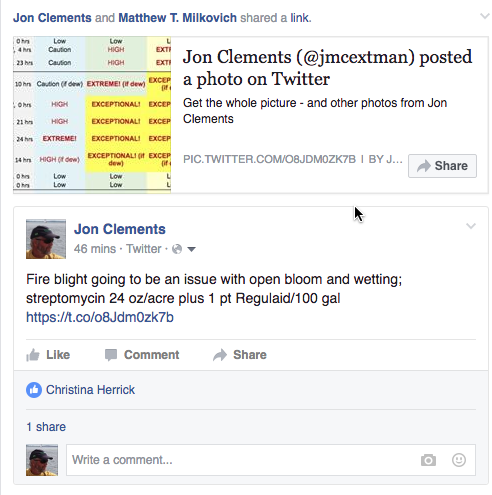
UMass Fruit Advisor: http://umassfruit.com
Scaffolds Fruit Journal: http://www.nysaes.cornell.edu/ent/scafolds/
Network for Environment and Weather Applications (NEWA): http://newa.cornell.edu
Follow me on Twitter (http://twitter.com/jmcextman) and Facebook (http://www.facebook.com/jmcextman)
Massachusetts Agricultural Calendar 2016 Photo Contest (Deadline is June 1)
The next Healthy Fruit will be published on Tuesday, May 31 (or thereabouts), 2016. As always feel free to get in touch with any member of the UMass Fruit Team (http://extension.umass.edu/fruitadvisor/team-members) if you have questions or comments.